Simple design solutions that can be added to existing workplaces to create environments where health and wellness are nurtured.
An average American currently spends about 8.4 hours on the job each day. They also spend about 30-minutes getting to and from the workplace, with super-commuters being the fastest growing contingent. For everyday workers, and the rise of remote careers notwithstanding, there is little time left in that equation to focus on their physical and mental wellbeing.
The design solution one arrives at is for the workplace to become an environment wherein health and wellness are nurtured. The workplace should, at a minimum, maintain an employee’s health but it could also become an environment that actively seeks to prevent unhealthy behaviors and the diseases that arise from them.
New buildings on the tech campuses of Silicon Valley have set commendable standards for the well-being of their staff. But what about everybody else and the already existing built environment? What are the pragmatic and meaningful interventions that facility managers and designers can make to create healthier environments and generate positive improvements for everyday workers?
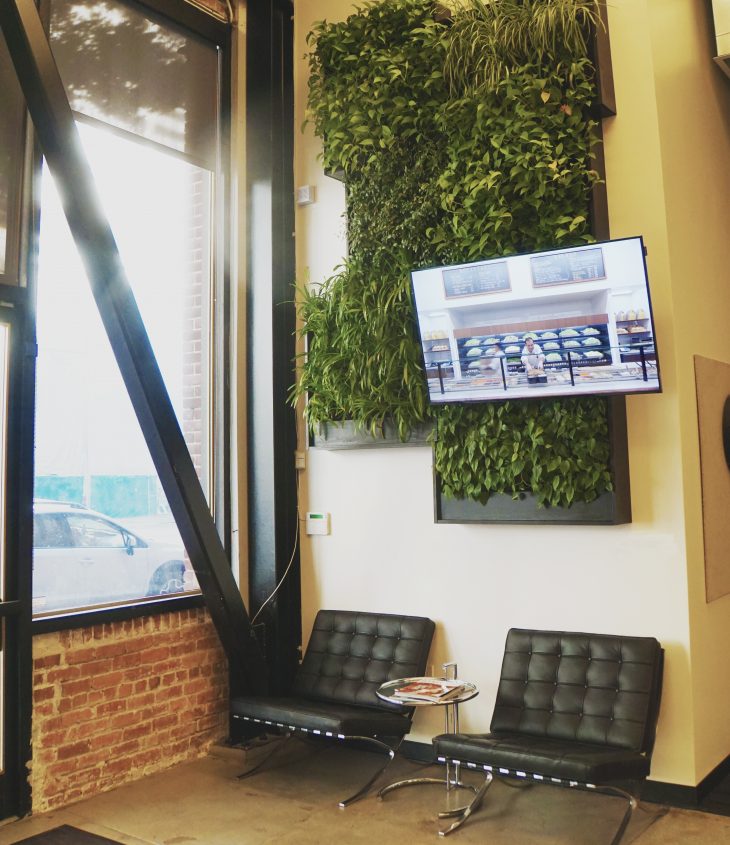
Extra-Small
At any scale, the immediate solutions to target are air quality through good ventilation and use of low-VOC materials, and also natural light if possible. At the smallest of scales, daylight may be impractical but the use of advanced lighting systems will help workers see clearly while avoiding disruption to natural circadian rhythms through brightness and color spectrum controls. A biophilic design strategy is also readily feasible.
The Fitwel group of researchers and designers have developed a set of standards by which companies can become certified based on the health and wellbeing of their employees. Their research has found that contact with nature in the workplace, through biophilic design, offers a simple approach to enhancing health and relieving stress.
Biophilic design is based on those parts of nature within which life thrives, and on the inherent human desire to connect to it. These natural interventions should form part of an integrated environment – something that can still be achieved in the smallest of work spaces through such things as green walls or potted plants which will filter carbon dioxide and VOCs. When interplayed with light and natural materials, one can very quickly create an inherent sense of comfort and wellbeing.
Active workstations are another useful, instantly achievable solution. They have been found to significantly increase daily physical activity and reduce the blight of sedentariness inherent in many contemporary professions.
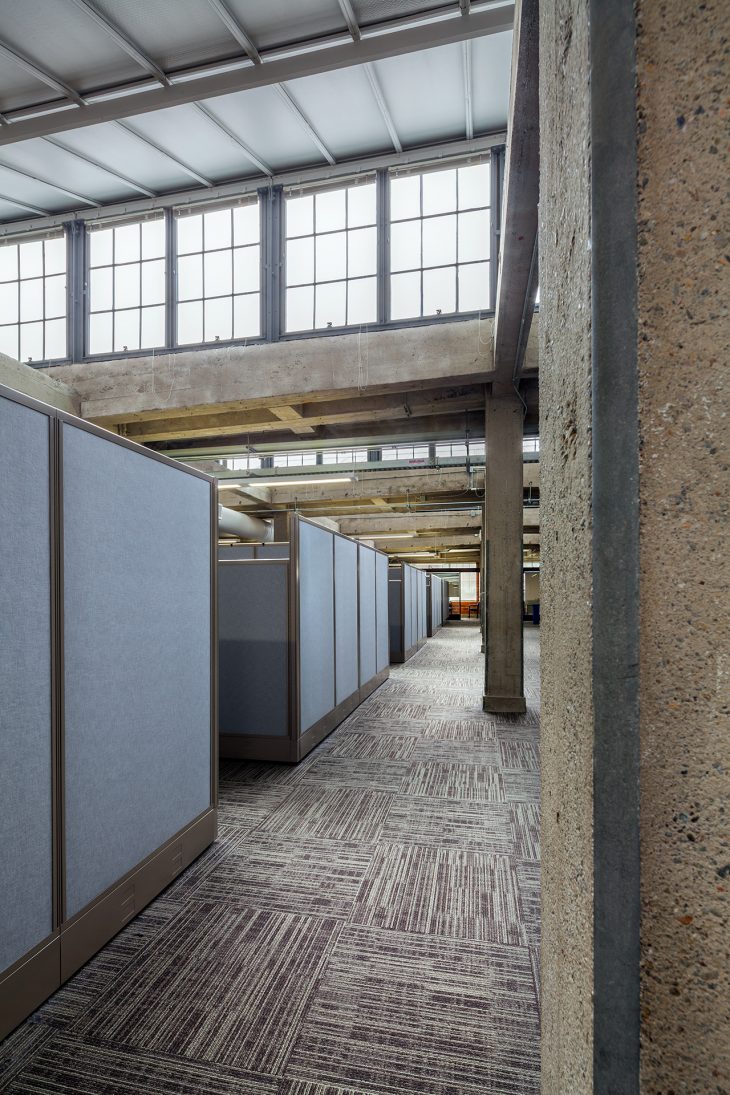
Small
A lot of conventional, existing office spaces are still warrens of corridors with imposing ACT ceiling systems. Circulation can be confusing and workstations are often quite claustrophobic. Even in relatively small areas, simply taking down interior walls, or replacing them with glazing, and raising ceilings can make a space much more hospitable.
WDA’s Hamilton Families project in San Francisco was a simple example of this. Project leader, David Plotkin speaks about how they “aimed to remove interior walls and maximize natural light to create a more welcoming, comfortable space. Our design exposed existing curtain walls, removed dark corridors, and improved flow.”
Natural light has been proven to be beneficial for the health and productivity through decreased stress levels. It also helps with the safety of building occupants, most simply by being able to clearly see what they are doing.
The challenge in this solution arises with the conflict between the bright and airy open-plan office, and the necessity for privacy in certain workspaces. Noise and privacy loss have been identified as sources of workplace dissatisfaction. There’s an argument for social interaction and the associated mental health benefits but there is a need for balance. WDA’s project for the San Francisco Human Services Agency is one way to achieve just that. Natural light and high ceilings create a sense of openness, while the tall workstation partitions still allow for privacy.
The next design iteration is to create a variety of spaces which workers can migrate to as required. That, however, is probably for larger spaces.
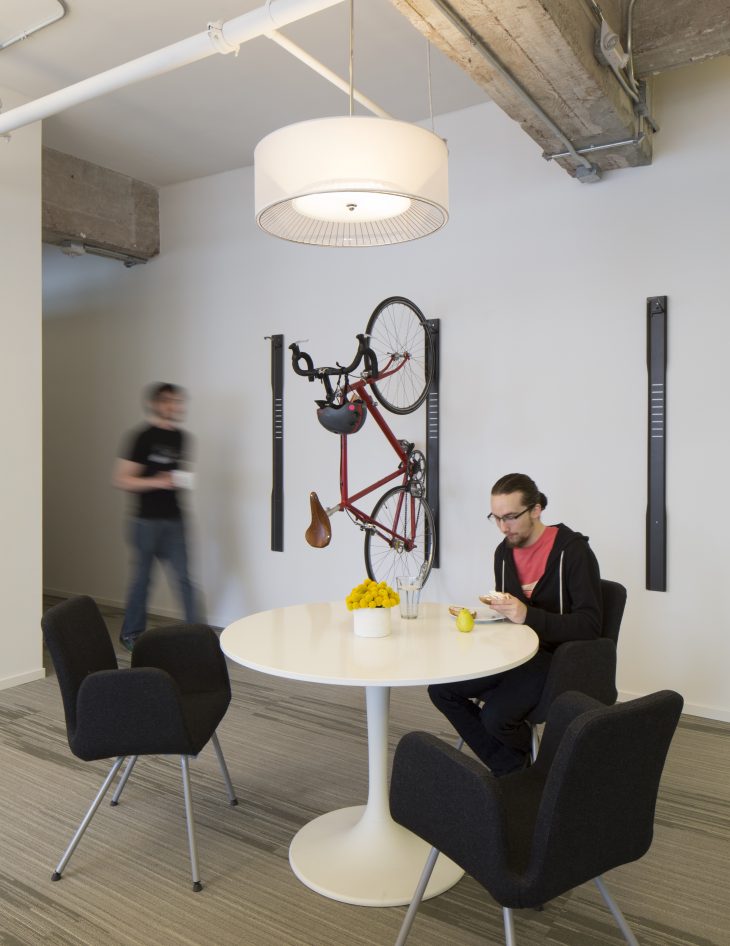
Medium
With an increase in area, there comes scope for the inclusion of much more diverse spaces, some of which will better solve the conflict between the health benefit of a bright and airy space and the need for private conversation.
Others though can start to serve workers health needs such as the promotion of physical activity. The City of New York published a set of Design Guidelines which speak to buildings being places which facilitate and encourage exercise. This resource is promoted by the Center for Active Design, which uses design to foster healthy and engaged communities.
This doesn’t need to be the scooter tracks of the tech campuses but simple bicycle storage which can be achieved with minimal loss of productive square footage. Just look in any millennial apartment in any major city and you will see plenty of creative, yet efficient means for storing bicycles in confined spaces.
If more space is available, then showers, lockers, and easily accessible drinking fountains might be incorporated which will be encouragement for bicycle commuting. They also present the opportunity for a lunchtime jog around the block or a local park.
The Fitwel group’s research found that the presence of workplace physical and cultural supports was related to more active commuting behavior and may especially encourage active commuting among women.
The Active Design Guidelines also promoted making stairs more likely to be used over elevators. In existing buildings this will likely be difficult to achieve, but fire-rated glass enclosures instead of typically opaque partition walls would be a start. The guidelines also suggest highlighting views of interest or towards nature, or perhaps more achievable interventions such as letting a stairs appeal to the senses through incorporation of artwork or the use of inviting colors.
As spaces get larger though, adequate ventilation and air circulation becomes ever more important. Installing large fans can ensure air keeps moving within a space, reducing the need for more powerful air conditioning systems, removing indoor air pollutants, and promoting a more consistent air quality throughout.
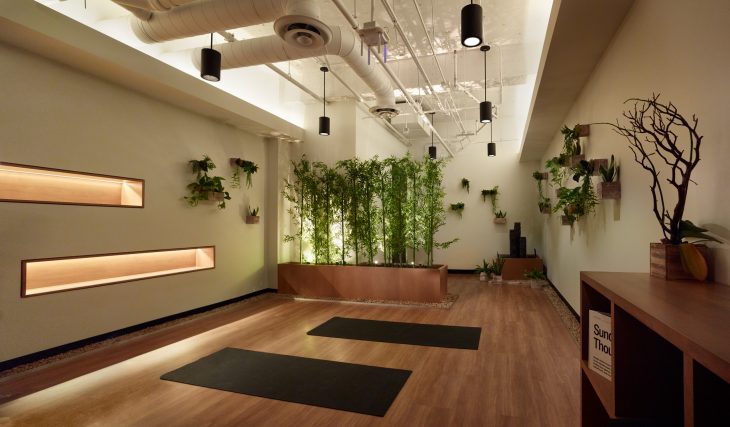
Large
At increased scales, designers should really look to incorporate all of the above. With larger buildings, however, comes larger groups of people and greater need, and difficulty, in keeping all happy, healthy, and productive.
With Uptake Technologies new, 88,000 sq.ft workspace in an old logistics building on the Chicago River originally built in 1908, Box Studios were given the scope to incorporate a range of spaces specifically designed with health and wellness of employees in mind. Specifically, they included the break area, the library, and the Zen Den. The variation between spaces here is critical.
With the Zen Den, intended at its essence to be a relaxing, mindful escape, Box Studios sought to create a “a space that supports physical, psychological and spiritual well-being in the office” through lighting controls and a warm materials palette.
The library, on the other hand, is typical of the type of solution called for by the noise and privacy issues of open-plan offices. It provides a space for concentration outside of the workstation. It is located in a back corner of the office, designated as a ‘destination’ where users can hide away and not be easily interrupted.
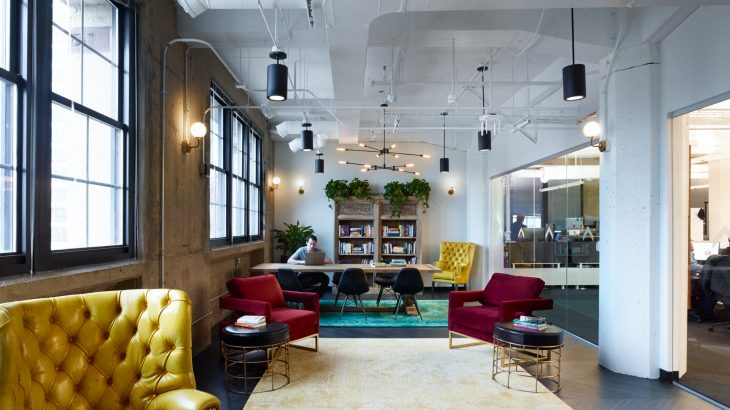
Extra-Large
The break area at Uptake Technologies in Chicago brings into focus many of the elements already discussed such as biophilic design. It is also a typical example of what can be achieved in any work environment, particularly when you move to the largest scale buildings.
Consider hospitals, and the nature of the work the many professions therein are required to do. There is an innate emotional labor to the work, to which Fitwell’s research cites studies that identify the humble staff break room as the uncelebrated antidote.
One study found that “the majority of nurses viewed high-quality break spaces as ‘fairly’ or ‘very’ important in terms of their potential to positively influence staff, patient and facility outcomes. Stress, rest breaks and the quality of break areas were some of the significant factors contributing to their perception.”
Naturally, the better designed these break areas are the better the quality of the break, the better the capacity for employee recuperation, and improved productivity. Which is the thing that really should make all of this a goal worth pursuing for corporate capitalists in the naturally lit corridors of power.
The Business Case for Wellness Interventions
Something as basic as access to natural light has been found to improve the health of workers and, importantly for employers, increase productivity in industrial environments due to improved color rendering and the better quality of light. With improved productivity there follows the financial benefits.
Indoor air quality, according to the Global Wellness Institute, costs the U.S. economy up to $168 million annually. A problem that could largely be solved through adequate ventilation which is readily achievable in almost any existing building.
Those are the most simple solutions, but in providing workers with healthy and inviting places to be in for over eight hours of their day, minimal further interventions are likely worthwhile, and potentially profitable, without undue burden.



[…] Purpose and Caring types, and you can cater to them with a variety of wellness-themed break rooms, like Box Studio’s “Zen Den.” But even if your company has very results-oriented employees that might benefit from space to […]